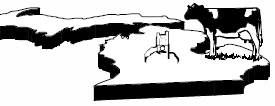



8 Ways to Beat the Summer Pasture Slump
By Doo-Hong Min and Rich Leep, Dept. of Crop and Soil Science and published in the Michigan Dairy Review by Michigan State University Extension. There is typically a slump for cool-season forages during the summer due to hot and dry weather conditions.Major symptoms of drought-stressed plants are slow or stunted growth, yellow-brown leaf color, and sometimes curled grass leaves or wilted legume stems. This will negatively affect plant growth and ultimately animal performance, resulting in economic loss. Here are several ways to beat summer slump for forages and pastures in Michigan.

- Plan ahead. Nobody knows exactly what kind of summer weather we will have but producers should prepare for the worst scenario from hot and dry weather conditions. A forage feed inventory should be performed to identify what feeding options are available based on the farm’s available resources. Planning in advance is very important. In the case of an extended drought, grazers should create a sacrifice area, field, or lot and supplement livestock with stored forages and grain. This will keep livestock off the remaining pasture paddocks to reduce damage to pasture forage from hoof traffic and will allow faster recovery when dry conditions are over. Livestock producers should not wait too long to begin supplemental feeding as animal performance and pasture forage health will decline quickly. When given the choice, livestock will continue to graze fresh forage versus eating stored forage, so a sacrifice lot is necessary.
- Leave 3 to 4 inches residual. Close grazing in early spring leaving a 2-inch residual helps pastures prepare for summer slump by encouraging grasses to tiller and send off sideshoots from the collar, thickening the stand. As the summer slump approaches, leave more residues (approximately 3 to 4 inches). This leaves a little more of a solar collector on the plants to help them recover faster by storing more root reserves and helps shade the ground so that it won’t dry out as fast.
- Stretch grazing rotations. In spring, pasture paddocks are rotated more frequently (every 20 days) due to fast plant growth resulting from optimal temperature and precipitation. However, hot and dry summer conditions result in slower forage growth. Therefore, paddock rotations should be stretched to every 35 to 40 days. This will give each paddock more time to recover and allow for more residues to cover the soil.
- Graze hay fields as needed. During the summer slump period, grazers can bring other hay fields into pasture purpose if they start to run out of pasture. Under drought conditions, all hay crop yields will be reduced, thereby increasing harvest costs like fuel and labor per ton of feed. Grazing can reduce these variable costs for one or two “cuttings” of the crop. In general, legume species such as alfalfa perform better than grasses due to a deeper tap root system resulting in better water use efficiency during dry weather. At the same time, take precautions to prevent bloat incidence.
- Consider warm-season annuals or perennials. When cool-season forages had severe summer slump in 2005, warm-season annuals (sorghum-sudangrass or millets) and perennials (switchgrass) were still able to grow. It is always important to have warm-season as well as cool-season forages in your dairy and beef operations to reduce the risk of poor crop growth due to unpredictable weather conditions. Since there are some dormant seeds, switchgrass seeds should be pre-chilled to break dormancy (if less than 40%) and consider using 10 lb. of pure live seed (PLS) per acre for conventional plantings. For example, 10 lb of pure live seed per acre is equal to 14.65 lb/A of actual amount of seeds (i.e., 14.65 lb/A = 10 PLS / (.975 x .70), where the purity is 97.5% and the germination is 70%.
- Watch your fertilizer. Putting any nitrogen fertilizer on dry ground with dormant stands during hot, dry weather is not recommended and can be a waste of time and money. However, nitrogen fertilization just before the end of a drought period will be very helpful for drought-damaged forages to recover faster once the rain comes back. Fertilizing pasture with nitrogen, phosphorus, and potassium at green-up and after first and second grazing cycles prior to dry conditions will help it survive a drought better than poorly fertilized pasture by having healthy stands and roots.
- Restore drought-damaged pasture. Drought effects tend to be more noticeable on coarse-textured sandy soils than on fine-textured clay soils. This is the same trend on poorly managed pastures. That’s why it is important to have optimal grazing and rest periods and fertilization before pasture starts to revive from drought damage quickly. Do not graze too early or overgraze drought-damaged plants. If pasture is grazed soon after the drought is over, there won’t be enough plant materials left for photosynthesis. Therefore, it is crucial to give forage plants an opportunity to replenish their energy reserves and establish new root growth after drought stress.
- Extend the grazing season. Last thing to consider is to replace lost summer forage yield due to dry weather. Consider a fall annual forage crop like brassicas (forage rape, turnip, or kale) or small grain forage to extend the grazing season and reduce the need for supplemental feeding of harvested forage. Often this can be done with little or no additional fertilizer, thereby keeping establishment costs very low. If the total cost to establish the crop is less than the cost to purchase equivalent replacement forage for feeding, then the situation is a win-win for the livestock and the producer.



